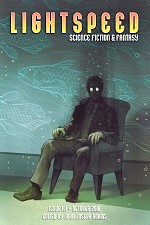“The Horror of Party Beach” by Dale Bailey
Reviewed by Victoria Silverwolf
Three short stories and one novelette appear in the latest issue of this award-winning magazine of fantasy and science fiction.
“The Horror of Party Beach” by Dale Bailey is the longest story in the issue. It borrows its title from an infamously bad film. As an old man, the narrator looks back on a terrifying event that happened when he was a high school student in the 1950s. He fell in love with the beautiful and brilliant daughter of a scientist conducting bizarre experiments in evolution. The results of her father’s research led to violence and tragedy.
The author tries to tell a serious story that makes use of themes from old monster movies. Although well written, with a climax gruesome enough for fans of horror fiction, the familiarity of the plot elements make the story predictable.
In “The Real YouTM” by Molly Tanzer, technology allows people to transform their faces into blank visages that reveal nothing about their features. The narrator undergoes such a procedure when, after a disastrous love affair, she loses her boyfriend, her lover, and her friend. The change in her appearance leads to a pair of unpleasant encounters.
The premise of the story is an interesting one. It serves as a metaphor for cosmetic surgery, tattoos, piercings, and other forms of changing the human body in search of perfection. The moral of the story, that altering one’s appearance does not guarantee happiness, is an obvious one. The protagonist is an unpleasant person, so it is difficult to sympathize with her plight.
Told in second person, present tense, “Super-Luminous Spiral” by Cameron Van Sant relates how you, as a mediocre student of creative writing, encounter a strange being. This humanoid creature has translucent blue and green skin filled with spinning spirals. After a sexual liaison with the being, you are able to write outstanding fiction. When it leaves you for another lover, you write at a frenzied pace, but only about infidelity. It turns out that many other students have the same experience. The final fate of the creature is unexpected.
This tale of a very unusual writers’ muse seems to be saying something about the creative process, but its message is unclear. The story’s strangeness, somewhere between surrealism and magic realism, holds the reader’s interest. Its narrative technique, and discussion of literary and genre fiction, may seem pretentious. This is a risk in any story dealing with writing.
“Ten Deals with the Indigo Snake” by Mel Kassel takes place in a fantastic version of the modern world. People are able to make magical bargains with talking snakes. As a teenager, the narrator obtains revenge against a bully in exchange for telling the snake its scientific name. As she grows up, she must make greater sacrifices in order to escape from dangerous situations. Eventually she comes to understand, accept, and control her dependence on the snake.
Many details make it clear that this is an allegory of addiction. The way in which the narrator grows more desperate in her need parallels that of a drug abuser or a compulsive gambler. Some of the events in the story are melodramatic, making the conclusion anticlimactic.
Victoria Silverwolf has seen The Horror of Party Beach.
 Lightspeed #101, October 2018
Lightspeed #101, October 2018